Vieux Télégraphe ‘La Crau’ was one of the first great Châteauneuf du Pape wines I tried. If you look closely at the header image on the Special Offers page you’ll see the tell tale word’s ‘La Crau’ from a bottle of 1999 I devoured a couple of years back! 16 years in the cellar saw it develop beautifully, incredibly sophisticated and layered with delicious flavours.
Alongside Beaucastel, Clos des Papes, Charvin, and, the epic Rayas, Vieux Télégraphe are one of the great established names of the region.
Domaine de Marcoux, is a new name for me, but, an ancient name for the region. The family have been making wine for over 700 years. Over the last 20 years they have elevated the estate to comfortably sit next to the greats of the world making refined, elegant wines, of, great intensity.
Domaine du Vieux Télégraphe
The Brunier family continues to turn out a beautiful array of wines, ranging from its value-priced Le Pigeoulet to their top-of-the-line, world-class Vieux Télégraphe Châteauneuf du Pape.
This estate is somewhat unusual in that it has 135 acres of contiguous parcels in the famous La Crau sector of Châteauneuf du Pape. It has one of the most precocious terroirs in the appellation, and is often among the first estate’s to harvest because of La Crau’s microclimate.
It’s hard to go past Kermit Lynch’s word on this wine:
Vieux Télégraphe’s greatest strength is undoubtedly its consistency. I am not referring to the consistency resulting from now four generations of Bruniers who know the plateau of La Crau stone for stone, as crucial as this is. Rather, I am alluding to the timeless power of this terroir, which allows for wines of noble character, profound complexity, and unrivalled typicity year in and year out. There is no question that vintage variation exists at Vieux Télégraphe – one need only taste two diametrically opposed vintages side by side, such as 2007 and 2008, to observe this phenomenon. Yet even in 2003, an infamous year in which climatic extremes all but erased the nuances of terroir across France’s wine regions, V.T. remains V.T. – ripe, no doubt, but defined more by stone than by fruit. And such is how La Crau asserts itself: the stones are omnipresent, supplying a firm spine to the wine, a salivating mineral aspect that refreshes regardless of the vintage’s overall balance.
Domaine de Marcoux
“The talented team of sisters Sophie and Catherine Armenier are gracefully carrying on the heritage of the Armenier family, which has been making Châteauneuf du Pape for only 700 years!… [the Vieilles Vignes] can be one of the greatest wines made in the world (the 1998 and 2000 for example), if not the single most phenomenal wine in Châteauneuf du Pape. The regular cuvee of Marcoux is no wimpy wine either. In top vintages, it is a powerful Châteauneuf du Pape that is given the same élevage…” Robert Parker, The World’s Greatest Wine Estates.
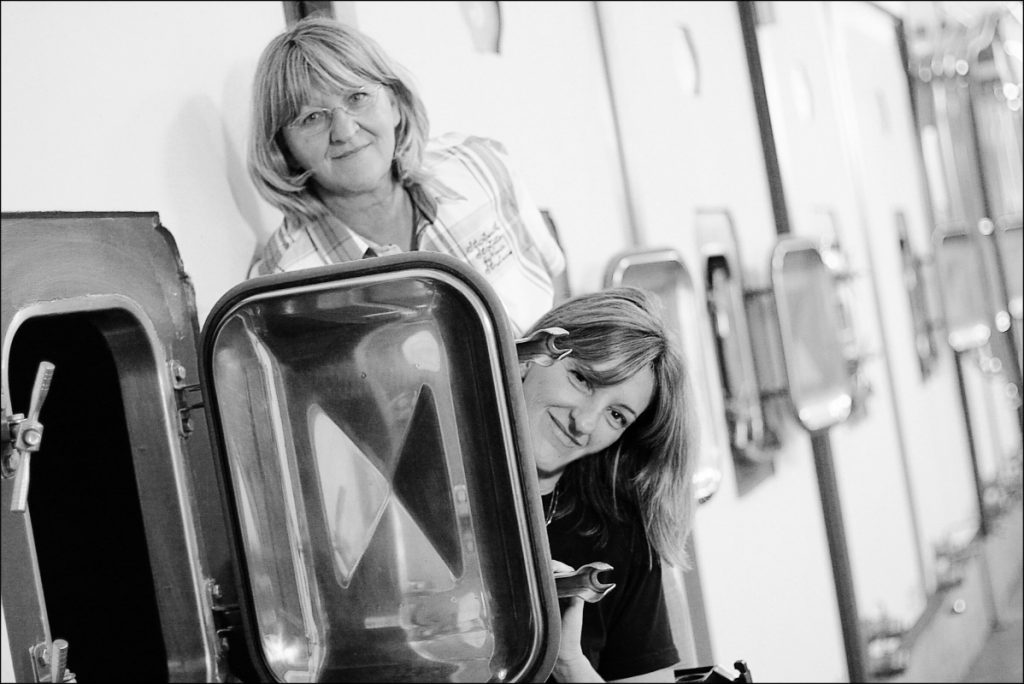
This tiny, artisanal Domaine is one of the French pioneers of biodynamic viticulture – they were the first in Châteauneuf to convert to biodynamics some 22 years ago. Since this time, and especially since 1996 when the Armenier sisters took full control of the Estate, Domaine de Marcoux has been on a steady path to becoming one of the true greats of the region. Yet, they are so small, only producing between two to four thousand cases for the world that for many, they remain a hidden treasure. To put things their volumes in perspective, this is roughly half the production of DRC and something like 1/10th of Beaucastel.
Marcoux has 17.5 hectares of vineyards dotted around the appellation and is therefore blessed with a cross-section of Châteauneuf terroir, from the region’s iconic large galets roulé, to sand, gravel and even limestone. The average vine age is about 50 years, whilst their the oldest vines have seen well over 100 vintages (I’m referring to Marcoux’s small parcel of gnarled, century-old Grenache rising up from a sea of river stones on the Charbonnières plateau near Crau). Marcoux’s Châteauneuf-du-Pape is drawn from 13 parcels of biodynamically farmed vines. These parcels encompass a wide range of soil types, from the aforementioned Charbonnières, to the red clay and galets in L’Arnesque and Les Bouquets, to the limestone and white clay in Les Esquirons and Beaurenard, and finally the red clay and gravels of Gallimardes, Les Serres and Les Plagnes in the south. This means Marcoux are able to produce a wine that truly reflects the Châteauneuf terroir as a whole. It also allows the Domaine to craft balanced wines year in year out as each parcel is vinified separately prior to the blending (and any parcels that do not fit the bill are usually sold to the negoce). In suitable years, the sisters release their cult Vieilles Vignes bottling. It is a 100% Grenache masterpiece, cut from from the estate’s three ‘crown-jewel’ parcels of exceptionally old vines in Charbonnières, les Esquierons and les Gallimardes.
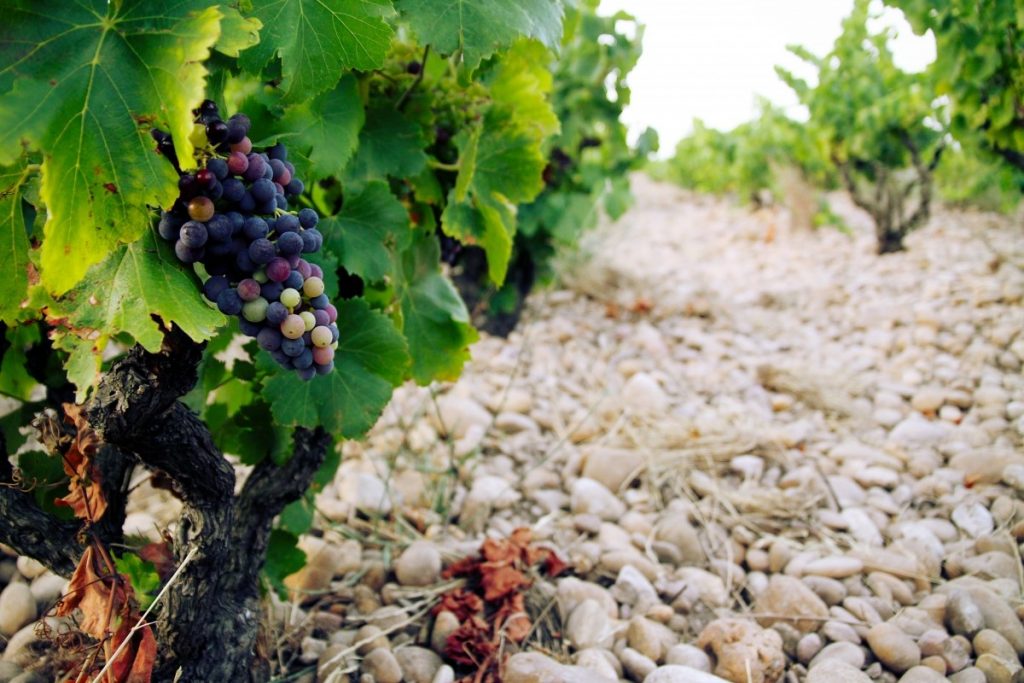
In a region renowned for ‘funk’, the Sophie and Catherine Armenier firmly subscribe to the fruit-equals-terroir school of wine. They love wines of purity, clarity, perfume, seduction and balance; a manifesto that can be tasted across the Domaine’s five wines. In the winery, the Armenier sisters meddle as little with the natural process as possible. With such pure and balanced ingredients, they don’t need to. All fermentations are natural and the wines see no new oak. Their winemaking principles can be described by quoting Sophie Armenier; “We interfere with the vinification as little as possible. We don’t do any pigeage to get colour, because we just don’t want to get in the way of the fruit.”
Lucidity and balance aren’t words you often find yourself thinking when drinking from Châteauneuf’s loving cup. Marcoux craft wonderfully pure, refined and textured examples that faithfully reflect the vintage in which they are produced. The “classique” is a brilliant Chateauneuf; intense and textured yet with the minerality and refinement that we rarely find in this region. For those who love the depth, power and longevity of old vine, low-yielding Châteauneuf, yet crave more elegance, these are wines to squirrel away in the cellar for special occasions in the future. The ‘Vieilles Vignes’ is simply one of the great wines of France – ultra powerful, layered and complex, it is a wine that will live and develop for decades. While this latter wine is all about the power and hedonism that ancient vines and their tiny yields generate in this part of the world, it is still nonetheless an incredibly complex and somehow balanced wine, despite its impossible concentration and ripeness. This is a timeless Estate whose delectable wines capture in Tanzer’s words, “…the essence of Chateauneuf du Pape”.
The 2015 Vintage
Vigneron Daniel Brunier describes 2015 as “a superb vintage that once again proves that nothing great can be done hurriedly.” His statement applies to the growing season, which necessitated late rains to restore balance to the drought-afflicted grapes, as well as to the harvest, an exercise in patience and restraint, and finally to the vinification, in which extended macerations yielded deep tannic structures that reached a seamless integration during the wine’s élevage.
In other words, 2015 showcases La Crau in all its glory. From its pure and explosive young fruit to the wine’s momentous structure, culminating in its trademark stoniness, this is V.T. as we love it and as we have always known it.
A bit of History
Châteauneuf-du-Pape literally translates to “The Pope’s new castle” and, indeed, the history of this appellation is firmly entwined with papal history. In 1308, Pope Clement V, former Archbishop of Bordeaux, relocated the papacy to the town of Avignon. Clement V and subsequent “Avignon Popes” were said to be great lovers of Burgundy wines and did much to promote it during the seventy-year duration of the Avignon Papacy. At the time, wine-growing around the town of Avignon was anything but illustrious. While the Avignon Papacy did much to advance the reputation of Burgundy wines, they were also promoting viticulture of the surrounding area, more specifically the area 5–10 km (3–6 mi) north of Avignon close to the banks of the Rhône. Prior to the Avignon Papacy, viticulture of that area had been initiated and maintained by the Bishops of Avignon, largely for local consumption.
Clement V was succeeded by John XXII who, as well as Burgundy wine, regularly drank the wines from the vineyards to the north and did much to improve viticultural practices there. Under John XXII, the wines of this area came to be known as “Vin du Pape”, this term later to become Châteauneuf-du-Pape. John XXII is also responsible for erecting the famous castle which stands as a symbol for the appellation.
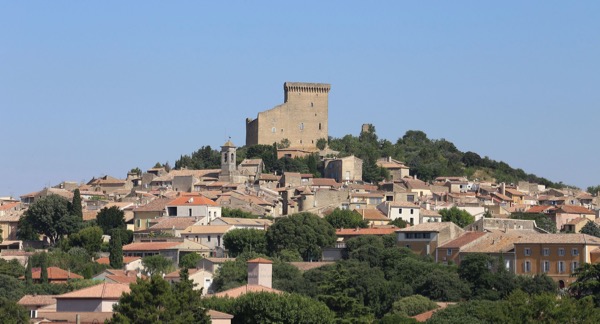
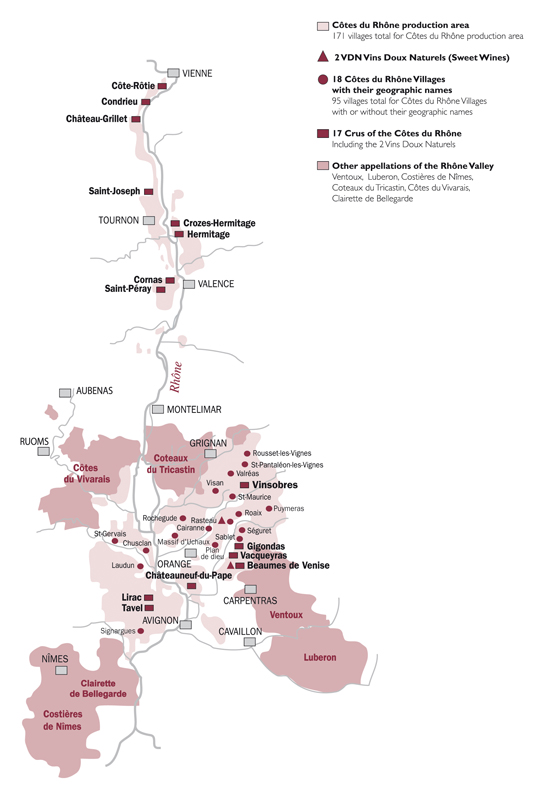
Click to enlarge 🔎
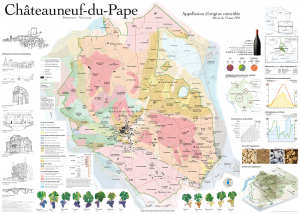
The Grape Varieties of Châteauneuf
Châteauneuf-du-Pape is traditionally cited as allowing thirteen grape varieties to be used, but the 2009 version of the AOC rules in fact list eighteen varieties, since blanc (white), rose (pink) and noir (black) versions of some grapes are now explicitly listed as separate varieties. Also in the previous version of the appellation rules, Grenache and Picpoul were associated with different pruning regulations in their noir and blanc versions, bringing the number of varieties previously mentioned from thirteen to fifteen.
Red varieties allowed are Cinsaut, Counoise, Grenache noir, Mourvèdre, Muscardin, Piquepoul noir, Syrah, Terret noir, and Vaccarèse (Brun Argenté). White and pink varieties are Bourboulenc, Clairette blanche, Clairette rose, Grenache blanc, Grenache gris, Picardan, Piquepoul blanc, Piquepoul gris, and Roussanne. (The varieties not specifically mentioned before 2009 are Clairette rose, Grenache gris and Piquepoul gris.)
Both red and white varieties are allowed in both red and white Châteauneuf-du-Pape. There are no restrictions as to the proportion of grape varieties to be used, and unlike the case with other appellations, the allowed grape varieties are not differentiated into principal varieties and accessory varieties. Thus, it is theoretically possible to produce varietal Châteauneuf-du-Pape from any of the eighteen allowed varieties. In reality, most Châteauneuf-du-Pape wines are blends dominated by Grenache. Only one of every 16 bottles produced in the region is white wine.
About the Wines
Wines from Domaine du Vieux Télégraphe
2016 Domaine du Vieux Télégraphe Châteauneuf du Pape Blanc
Remarkably fragrant with just the right mix of minerality and noble unctuousness, appealing now but built to last, too. The grapes are from the famed La Crau vineyard—beat that terroir if you can!
GRAPE VARIETIES: clairette 40%, grenache blanc 25%, roussane 25% and bourboulenc 10%.
VINE AGE: 45 years on average.
VINIFICATION: grapes are hand-picked, with double sorting at the vine, then a third sorting in the winery. Pneumatic pressing, then static settling. Fermented in barriques, demi-muids and 30 hl foudres.
MATURATION: on the lees in barriques, demi-muids and 30 hl foudres. Bottled at 1 year.
PERSONALITY AND AGEING: a member of the classic school of white Châteauneuf-du-Pape: more floral than fruity aromas, and characterised by balance and freshness. It might dip in form between four and eight years, but the best vintages age as well as the reds.
SERVING TEMPERATURE: 12°C.
Ripe and rich, but focused, with verbena, bitter almond and wet stone notes threading through the core of creamed yellow apple, pear and melon flavors. Very long, with a gorgeous salted butter echo. Drink now through 2020.
2015 Domaine du Vieux Télégraphe Châteauneuf du Pape Blanc
The 2015 Châteauneuf du Pape Blanc is another outstanding white from this estate. Made from 40% Clairette, 30% Grenache, 15% Roussanne and the rest Bourboulenc, all from La Crau, it’s a layered, classic white from appellation that has plenty of pear and stone fruits.
A blend of 40% clairette with the balance grenache blanc and bourboulenc in equal parts. The palate is crisp and floral, with dried flowers and chalk. An extremely savory and stony expression. Impressive. Average vine age of 50 years. Drink now.
While I’ve always loved the white from the Brunier brothers, the 2015 Châteauneuf du Pape Blanc is the finest example of this cuvée I can remember tasting. It’s light gold color is followed by an impeccably balanced, ultra-pure, seamless white that has complex notes of white flowers, hazelnuts, just crushed rocks and citrus blossom. This beauty doesn’t hit you over the head with fruit or sweetness, yet grows on you with time in the glass. You can drink it today, as well as cellar it for two decades.
2015 Domaine du Vieux Télégraphe Télégramme Châteauneuf du Pape
GRAPE VARIETIES: grenache 80%, syrah 10%, mourvèdre 6% and cinsault 4%. VINE AGE: 40 years on average.
VINIFICATION: grapes are hand-picked, with double sorting at the vine, then a third sorting in the winery. They are destemmed, followed by 25-30 days’ traditional fermentation in temperaturecontrolled vats. Pneumatic pressing, then systematic malolactic fermentation.
MATURATION: in vats for 10 months, then in French oak foudres (30 hl) for about 7 months. Bottled at 15-16 months, released at 18 months.
PERSONALITY AND AGEING: a Châteauneufdu-Pape seriously dominated by Grenache, which confers very singular suppleness and roundness. Best savoured young.
SERVING TEMPERATURE: 17°C
A silky, elegant style, with light blood orange, bitter cherry and damson plum fruit stretching out over sandalwood, bergamot and incense notes.
Gentle but persistent through the finish. Drink now through 2027.
Bottled after 18 months (other Châteauneuf-du-Papes see 24 months in cask). This is from the vineyards around La Crau. Fresh, bright raspberry and strawberry fruit aromas with a smooth, ripe and red plum-flavored palate. Pastry-like layers of fine tannins. Drink now.
2015 Domaine du Vieux Télégraphe Châteauneuf du Pape ‘La Crau’
GRAPE VARIETIES: Grenache Noir 65%, Mourvèdre 15%, Syrah 15%, Cinsault, Clairette and sundry others 5%.
VINE AGE: 65 years on average.
VINIFICATION: grapes are hand-picked, with double sorting at the vine, then a third sorting in the winery. Gentle pressing and selective destemming, followed by 25-40 days’ traditional fermentation in temperature–controlled stainless-steel and wooden vats. Pneumatic pressing, then systematic malolactic fermentation.
MATURATION: 20-22 months in French oak foudres (60hl). Bottled unfined and unfiltered, then released at 2 years.
PERSONALITY AND AGEING: a classic red Châteauneuf-du-Pape, very fine and elegant. The best vintages will age for 25 years and more.
SERVING TEMPERATURE: 17°C.
This has a lovely, perfumy mix of savory, mint, tobacco, blood orange, cherry and bergamot notes all mixed together, carried by silky but ample structure before ending with a long, mineral- and shiso leaf—infused finish. Finely beaded acidity lets everything hang wonderfully. This should expand and cruise in the cellar. Best from 2020 through 2035.
The flagship wine, the 2015 Chateauneuf du Pape, is a blend of 60% Grenache, 20% Mourvèdre, 15% Syrah and 5% other permitted varieties. It features delicate floral scents and ample cherry and licorice aromas. Somehow, it manages to be full-bodied and almost creamy in texture but without much weight, then it ends powerfully, with a flourish of rich Mexican chocolate on the long, silky finish. It should drink well for up to 20 years.
A wine with playful, attractive character. An array of red, blue and purple fruits. Gently spicy, chalky and fragrant, it has a very supple, fleshy and layered palate with a web of fine, smooth and supple tannins. Extremely elegant and composed. A long draw on the finish. Great depth and drive. This will live super long. Try after 2020.
Domaine de Marcoux
Domaine de Marcoux Châteauneuf-Du-Pape 2015 MAGNUM ONLY
The Chateauneuf-du-Pape Rouge, the bulk of the production at Domaine de Marcoux, is sourced from 13 sites spread over a wide range of terroirs. This allows for a wine that is both dense but pure and lifted with beguiling aromatics. In general terms Marcoux is always inclined towards red-fruit flavors with a smoky stoniness that emerges with age.
Blend: 80% Grenache, 10% Mourvedre, 5% Syrah, 5% Cinsault
Ruby-red. Energetic, mineral-accented aromas of ripe red and dark berries, complicated by suggestions of incense and pungent flowers. Broad and fleshy on entry, then more taut in the midpalate, offering pliant black raspberry and bitter cherry flavors and a suggestion of five-spice powder. Finishes very long and sweet, featuring slow-building tannins, a touch of smokiness and repeating red fruit character. This wine is shaping up to be an outstanding "basic" Châteauneuf.
Raised mostly in concrete, the 2015 Chateauneuf du Pape features gentle strawberry-raspberry fruit and loads of subtle spice. It's medium to full-bodied, marked by silky tannins and a long finish. It's not the most powerful, concentrated wine, but it's certainly one of the most elegant. It's 85% Grenache, with the balance a mix of Mourvèdre, Syrah and Cinsault.
Domaine de Marcoux Châteauneuf-Du-Pape Vielles Vignes 2015
In suitable years, the sisters release their cult Vieilles Vignes bottling. It is a 100% Grenache masterpiece, cut from from the estate’s three ‘crown-jewel’ parcels of exceptionally old vines in Charbonnières, les Esquierons and les Gallimardes.
“Domaine de Marcoux is one of [Châteauneuf’s] greatest success stories of recent years; the wines are ambitiously crafted by Sophie Armenier, with a particularly sensational old-vines bottling that demonstrates just how far this estate has come since 2000.” Bettane et Desseauve’s Guide to the Wines of France.
Lurid ruby. A heady, expressive bouquet evokes fresh raspberry, cherry compote, potpourri, licorice and Asian spices, while a bright mineral flourish builds in the glass. Sweet, palate-staining red fruit liqueur, lavender pastille and spicecake flavors show outstanding depth as well as vivacity thanks to a core of juicy acidity. Plays power off finesse with a deft hand and finishes incredibly long, sappy and pure; velvety tannins emerge very slowly. I wouldn't be at all surprised to see this monumental wine turn out to be the star of the 2015 vintage in the Rhône Valley, south as well as north.
The 2015 Chateauneuf du Pape Vieilles Vignes (about 97% Grenache) was entirely destemmed. According to Sophie Armenier, its alcohol level is a whopping 16+%, but it was completely concealed by the wine's intricate spice complexities. Licorice, cola, cinnamon, clove and allspice all interweave with cherries to form a silky web that glides across the palate and into a long, long finish.
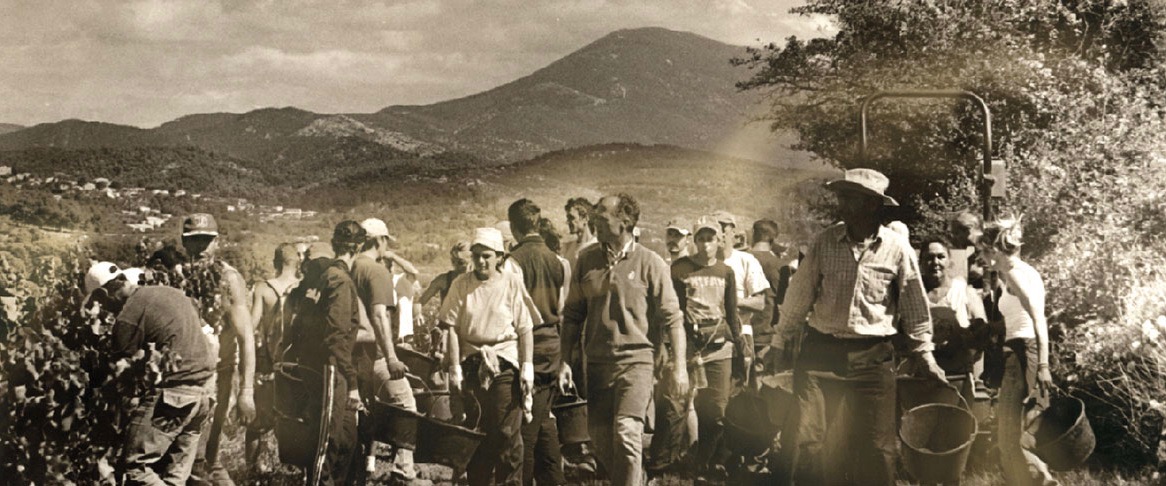



You must be logged in to post a comment.